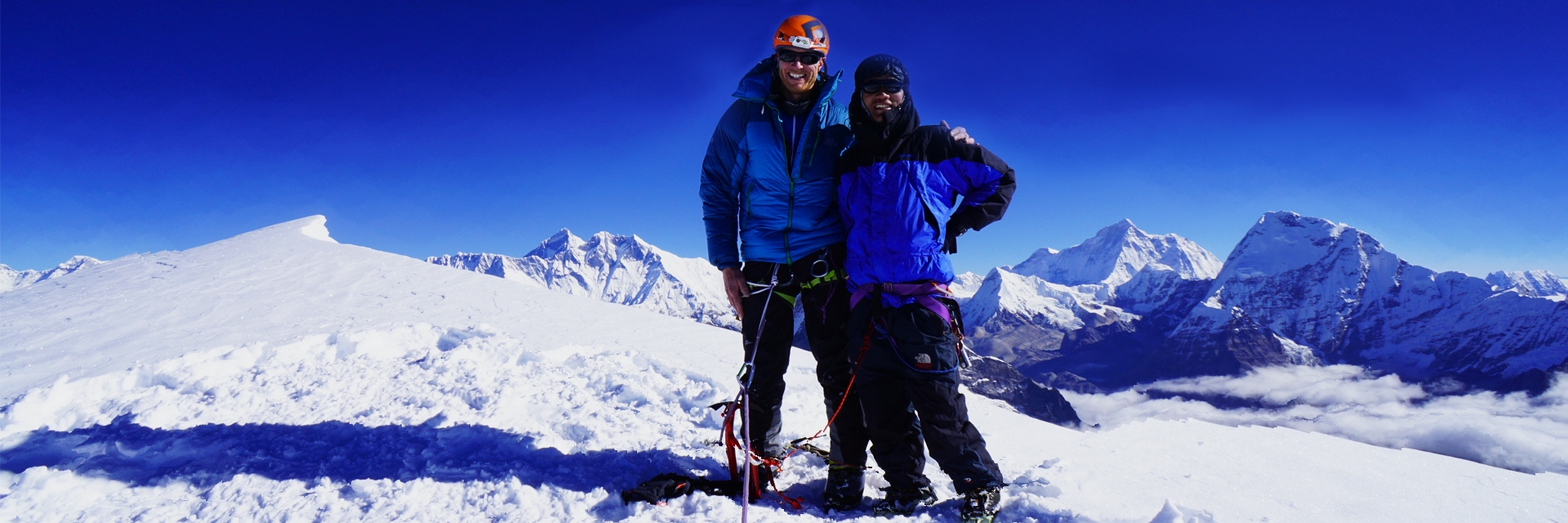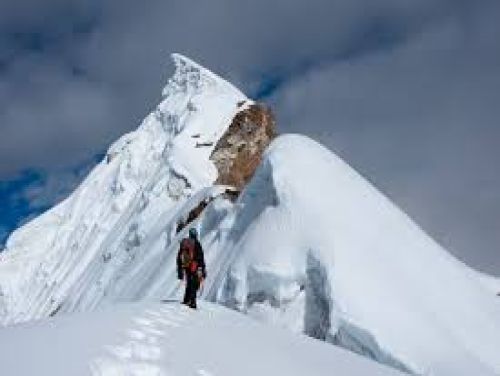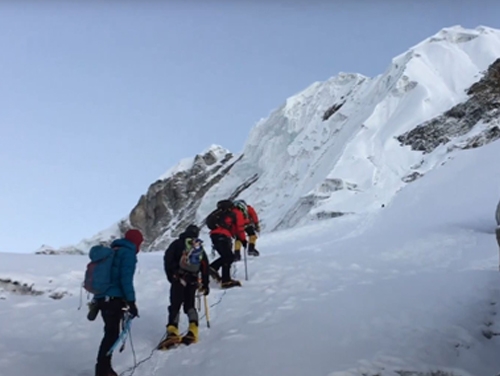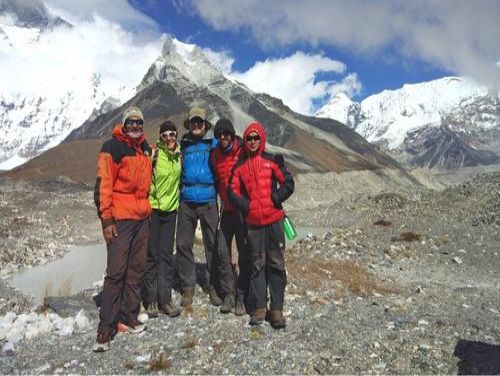Overview of Mera Peak Climbing
Nepal contains Mera Peak (6,476 meters), representing the highest trekking peak in the country's Everest region. Those looking for high-altitude peaks can embark on Mera Peak as an accessible adventure for climbers.
The Mera Peak summit provides breathtaking views across Everest and three other world giant peaks: Lhotse, Makalu, Cho Oyu, and Kanchenjunga. The trek to reach Mera Peak guides people through sherpa villages while crossing green forests and impressive glacial expanses.
The journey starts with a flight that departs from Kathmandu to Lukla and continues with an exploration of the Hinku Valley alongside gorgeous scenic views.
Hikers travelling Mera Peak's trail will encounter Sherpa communities, where they can see authentic village life and greet friendly local people.
Travelling to Mera Peak Base Camp requires trekkers to go through rhododendron forests and cross high mountain passes followed by glaciers. Adequate acclimatization should be done to resist altitude sickness.
Experienced mountaineers use crampons, ropes, and ice axes as basic climbing tools. Before climbing the summit, many climbers do small training exercises. The glacier walking section forms the last phase of the pathway, as it includes sloppy lands.
The Mera Peak climbing varies between 15 and 18 days according to chosen schedules. The optimal time for climbing at Mera Peak is from March to May during the spring season and from September to November during the autumn season.
To make this climb possible, climbers must obtain a climbing permit. The combination of adequate preparation will allow Mera Peak to provide a unique expedition experience to all climbers and trekkers.
Things You Can Experience in Mera Peak Climbing
Mera Peak climbing presents beautiful forest trails, Sherpa village, and unforgettable panoramas across Hinku Valley. This adventure consists of a glacier mountaineering walk alongside basic mountaineering tools and a challenging climb to 6,476 meters.
The highest position on Mera Peak provides a complete view of the world's five tallest mountains which include Lhotse, Makalu, Cho Oyu, Everest, and Kanchenjunga.
Breathtaking Mountain Views
As you trek Mera Peak, you will witness unbelievable panoramic mountain views that include Everest, Lhotse, Makalu, Cho Oyu, and Kanchenjunga. The Hinku Valley trek provides snow-capped peaks, glaciers, and deep valleys that form an extraordinary natural scene.
On reaching the summit at 6,476 meters, you will get an unforgettable panoramic view of Himalayan peaks that spark in sunlight.
High-Altitude Adventure
Mera Peak climbing enables explorers to climb the Himalayas' heights and reach 6,476 meters above sea level. Walking on snow and ice while using basic climbing gear like ropes and crampons enables you to achieve the summit experience.
Your physical tests will be put to the ultimate challenge by the journey, yet its breathtaking mountain views will make every struggle worth it.
Trekking Through Pristine Landscapes
The journey to Mera Peak provides a pristine view of untouched beautiful landscapes. Walking along the green forests will take you across rivers until you reach the beautiful Sherpa villages. The peaceful nature of the trip is enhanced by the Hinku Valley, settled in a snowy area beneath the snow-capped mountains.
Cultural immersion
Participating in Mera Peak climbing exposes you to the exclusive Sherpa cultural traditions. Visitors will step through traditional villages before seeing Buddhist monasteries and making contact with local people.
Glacier and Ice Climbing
Walking on glaciers and icy slopes is a part of Mera Peak climbing. Safety equipment, such as crampons alongside ropes and ice axes, will be utilized during your expedition. Snow climbing delivers thrilling feelings and actual adventure thrills.
Physical and Mental Challenges
The Mera Peak climbing journey presents dual physical and mental challenges to its climbers. The climb requires many days of trekking across steep ice slopes as you walk through cold weather conditions. Your journey to summit success depends on staying strong mentally and physically while keeping a determined focus.
Remote and Off-the-Beaten-Path Adventure
The remote nature of Mera Peak provides visitors with an adventure beyond typical trails. Your journey will lead you through peaceful regions filled with minimal trail congestion. The location offers peace with genuine Himalayan surroundings that embrace natural beauty.
Sunrise from the Summit
A sunrise view from Mera Peak summit creates memories that will never fade. The snowy peaks create a magical sight when the sun shines upon them, producing golden light. The mountain summit delivers both peace and fulfilment after facing tiring mountaineering.
Preparation for Higher Expeditions
People climb Mera Peak as their initial climbing for more challenging mountain climbs. The climb teaches necessary skills while developing your strength, allowing you to acclimate to mountain heights. Your practical experience during the Mera Peak climb gives you the confidence to face larger difficulties.
Diverse landscape
Climbing Mera Peak takes you through multiple landscapes, forest areas, and snowy mountain summits. Your path will take you across flowing rivers as well as past glaciers and stunning alpine grasslands. You can experience the blend of exciting and beautiful scenery because the environment constantly transforms.
Is Mera Peak Climbing for beginners?
Beginners can choose Mera Peak climbing as it gives a good high-altitude mountaineering experience. The mountain peak reaches 6,476 meters in height, making it available to climbers with normal fitness abilities due to its non-technical nature.
Learning basic climbing equipment skills with crampons and ice axes together with ropes is essential before attempting the climb. Mera Peak presents a difficult climb that demands some physical work for new climbers.
Mera Peak trek delivers an outstanding entry to explore the Himalayan mountain range. Your journey will take you through stunning forests with charming villages along fantastic valleys by admiring Everest, Lhotse, and Makalu.
The Mera Peak Itinerary includes dedicated rest days to enable your body's adaptation to high elevation levels, guaranteeing secure travel. Through appropriate training and support, beginners will be able to climb Mera Peak while enjoying this Himalayan mountaineering adventure.
Preparation for Mera Peak climbing
Mera Peak climbing demands physical and mental preparedness as the main components of the training process. Regular exercise such as walking, running, and strength training should be your first step to achieving fitness.
Train your body to develop enough stamina for extensive hiking and mountaineering at high altitudes. Basic mountaineering equipment, such as crampons with ice axes and ropes, requires practice since these tools are necessary during glacier climbing sections.
Altitude sickness knowledge becomes essential because Mera Peak reaches a height of 6,476 meters. The trek plan includes scheduled acclimatization days, which help your body adjust to heights above 6000 meters.
The proper equipment for cold and snowy conditions should be multiple layers of warm clothing, sturdy boots, gloves, and a quality sleeping bag.
Using an experienced guide or participating in a guided trek delivers safety protection and continuous assistance during the entire climb.
Join a group for Mera Peak climbing
Traveling with a group on Mera Peak climbing enhances safety with mutual support throughout the climbing adventure.
The experienced guides who lead group climbs ensure safe navigation through the path, providing solutions to altitude sickness and handling adverse weather conditions.
Members of a trekking group benefit from sharing the thrill of adventure with new friends and providing mutual support when challenges arise.
Group climbing organizations provide necessary equipment, including crampons, ice axes, and ropes while they handle all permit arrangements for climbers. The scheduled itinerary features rest days that enable people to adjust to high-altitude conditions.
Organized climbing groups provide equipment and permits that simplify the physical and mental obstacles during the climb. Joined groups provide cost-effective mountain climbing compared to individual efforts while providing complete professional support from start to finish.
Group size for Mera Peak climbing
Mera Peak climbing is best undertaken with groups consisting of 4 to 12 members since this number ensures safety and enjoyment for everyone. The small group size lets guides give individualized guidance to all the members.
Trekking companies determine group sizes that maintain a safe balance to promote a collaborative pace along with secure travel.
While travelling with a group, the guide and porters manage tasks like path selection and equipment transportation, which frees up climbers to focus on the trekking experience.
A group's moderate size allows for controlled movement, particularly during high-altitude acclimatization and unexpected situations.
Small groups tend to be desirable for those who desire personal service, while mass groups offer more economical options. Organizing yourself into a group protects you during your climb.
Mera Peak Success Rate
Mera Peak attracts 200-300 climbers who complete their summit climb each annual season. Weather patterns, season, and climber's level of preparation determine how many people successfully summit Mera Peak each year.
You should aim for the spring (March to May) and autumn (September to November) periods for your climb since these months offer the clearest and most stable weather conditions.
Mera Peak ranks as a non-technical climb yet climbers need suitable physical fitness together with appropriate acclimatization and basic mountaineering skills.
Most climbers reach their summit goals when they follow their planned route while maintaining a steady pace after conducting proper preparations. Guides and support teams with experience lead the way to ensure climbers stay safe while providing assistance throughout the climbing process.
Climbers from all around the world find completing this peak climb to be a rewarding accomplishment during each yearly trekking season.





